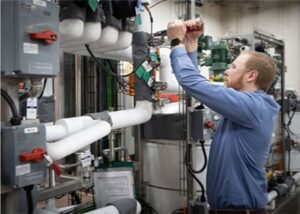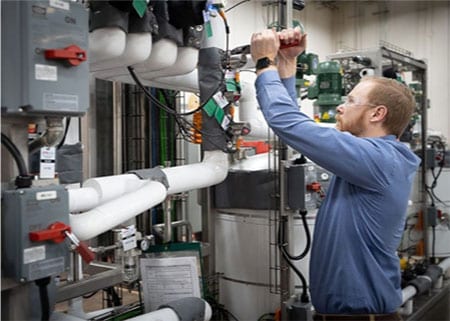[vc_row][vc_column][vc_column_text]
What is the Process for Pilot Plant Scale-Up?
If this is your first time scaling a process technology from the lab, the first thing you need to understand is that pilot plant scale-up is not a linear process. What this means is you cannot take a chemical process from the lab, increase the chemicals and equipment, and simply slap them together into a pilot plant. When you scale-up the size of your chemical process, several properties related to system size (reaction kinetics, chemical equilibrium, etc.) will also change. In this blog post, we’ll define eight key challenges you can address to ensure a successful pilot plant scale-up. Before we begin, let’s take a minute to review the necessary steps of any pilot plant scale-up.
As the video illustrates, proper pilot plant scale-up technique requires you to complete the following steps:
- Front End Loading (also known as Front End Engineering)
- Process Simulation & Module Design
- Pilot Plant Fabrication
- Logistics and Installation
- Startup & Commissioning
What are the Challenges to Pilot Plant Scale-Up?
You’ll need to conduct several in-depth engineering studies to overcome the challenges associated with your pilot plant scale-up. Be sure to consider front end loading and scale-up design in modeling software during the design stage. You can use Semi-empirical modeling methods to determine the limitations of your technology through modeling. It’s important to establish that the chemical technology can be scaled up to produce the required output for an acceptable cost before you sign a final purchase order. Now, let’s break down the most common challenges that occur during a pilot plant scale-up.
1. Non-Linear Scale-Up

For example, a chemical reaction in a beaker requires a certain amount of “chemical A” and a certain amount of “chemical B”. The beaker is a certain size. The reaction between these two chemicals results in a certain amount of “chemical C” and a specific amount of heat being released. If you linearly scaled this system, increased the beaker size 500 times to a tank, and increased the amounts of chemicals “A” and “B” by 500 times, then you would expect have 500 times the amount of “chemical C” and 500 times more heat released. Right? Maybe not.
Several factors could be affecting your reaction. A tank that is 500 times larger than a beaker has a completely different relationship with the mass of chemicals inside. A beaker will have more contact with the fluid contained than a large tank would. This is because the majority of the chemicals in a tank do not touch the walls of the tank. This is the surface area to mass relationship that affects the physical properties of a reaction.
2. Reaction Kinetics
Molecules in a reaction need to mix well to reach the state of equilibrium as quickly as possible. There are various physical and chemical factors that can prevent mixing and colliding from happening efficiently, resulting in bad reaction kinetics.
3. Chemical Equilibrium
The time to reach chemical equilibrium increases as larger quantities of chemicals are mixed. A reaction is not productive until chemical equilibrium is reached.
4. Material Properties
The physical and chemical properties of the materials in contact with the reaction can influence the reaction, erode over time, or drive the cost of the system up unnecessarily. Material selection is therefore extremely important.
5. Fluid Dynamics
Fluid dynamics change at a non-linear rate as systems increase in size. Keeping flow at the correct Reynolds number is important for thermal transfer and mixing efficiency. Changes between laminar and turbulent flow are hard to predict because of the non-linear nature of fluid dynamics.
6. Thermodynamics
A thorough thermodynamic analysis is necessary for successful pilot plant scale-up due to the sensitivity of chemical reactions to heat gain and heat loss.
7. Equipment Selection
Equipment physical limitations can seriously impact chemical reactions. Incorrectly sized equipment can make it hard to control reactions, affect thermodynamics, fluid dynamics, and other aspects of reactions. System longevity also relies heavily on correct equipment selection. Furthermore, materials of construction that are easily available at a bench-scale may not be available or affordable in the quantities required for large-scale systems.
8. Agitation Issues
The correct amount of turbulence within a system is critical to creating good reaction kinetics. Angled agitators and baffles can be used to increase turbulence, and the issue of stirring must be addressed.
[/vc_column_text][vc_row_inner][vc_column_inner][ultimate_heading main_heading=”Ready to talk to an engineer?”]Give us a call at 314-806-1678 or fill out the form below.[/ultimate_heading]
"*" indicates required fields
